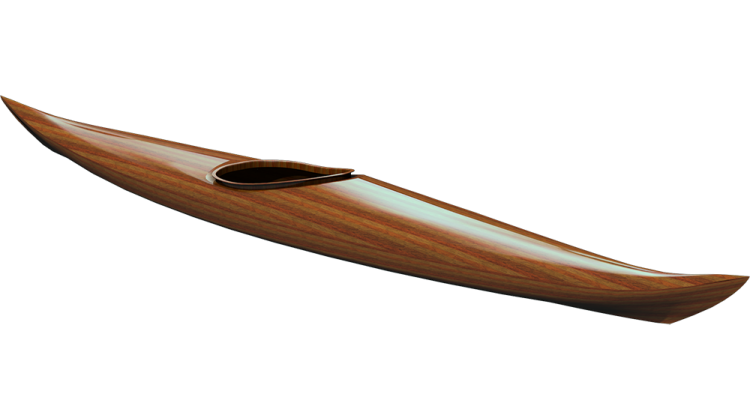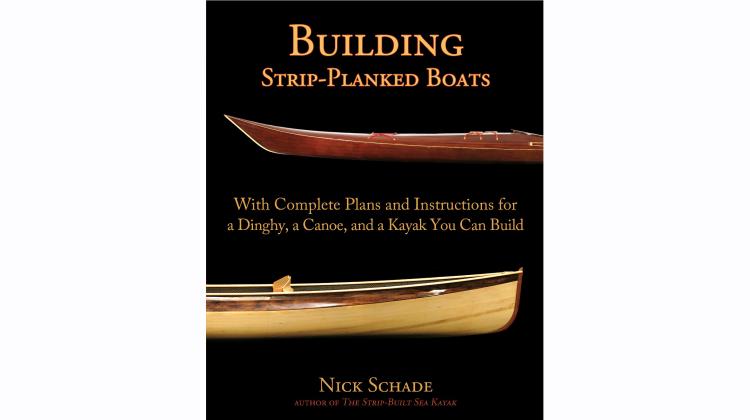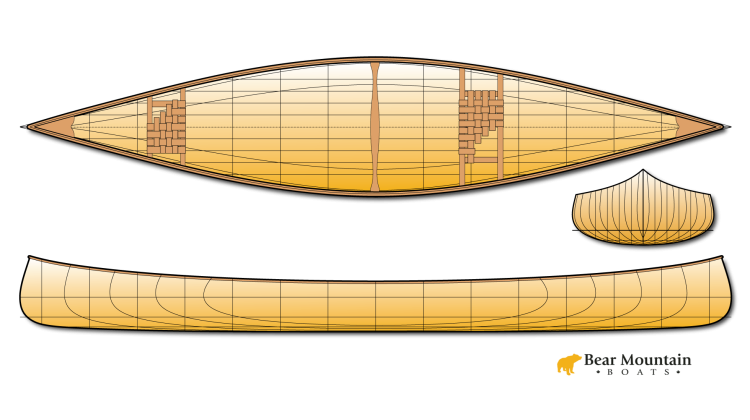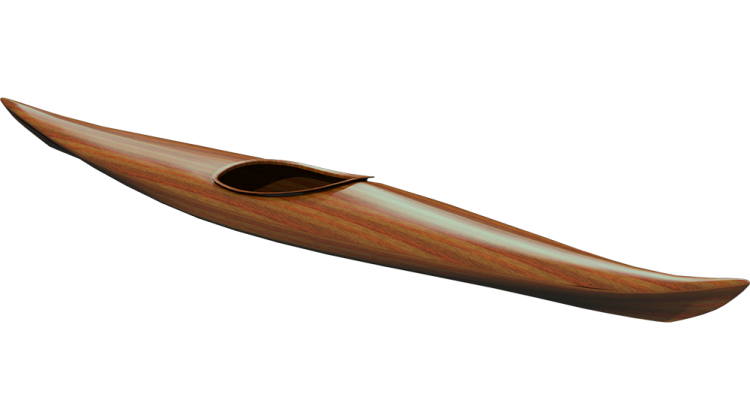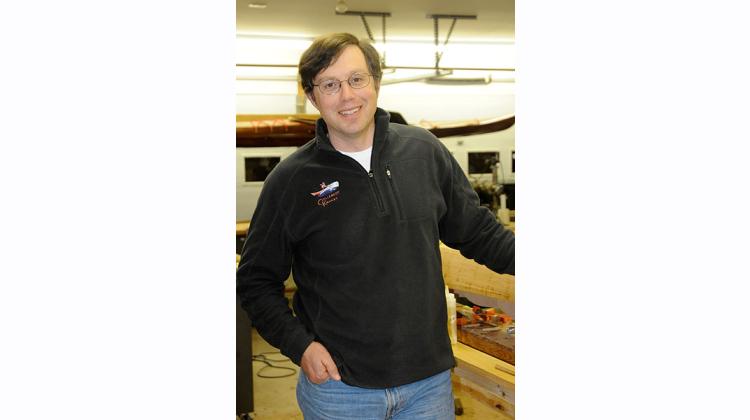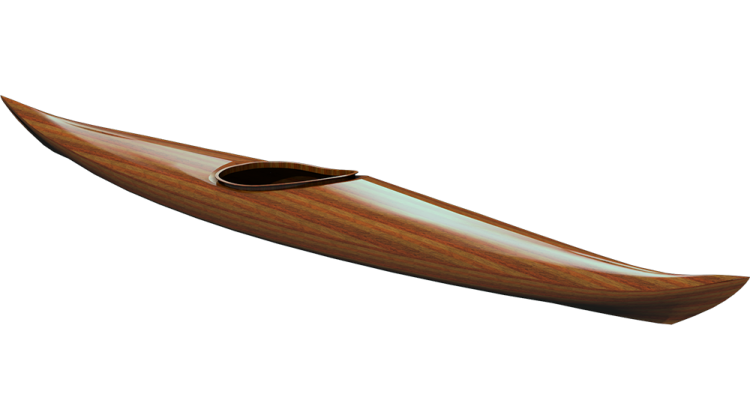Preparation
The hole pretty much defines the shape so cutting the hole accurately is step one. Since that step the boat has been fiberglassed and the rough edges left over from that need to be cleaned up. I want to be sure all the end grain is well sealed up and one way to do that is to cover end grain with a wood that does not absorb water well, such as maple. I heated up a thin strip of curly maple to bend it around the thigh braces. This strip is then glued down and taped in place. After the glue dries and the tape comes off I sanded it all smooth and put a radius on the edge with sandpaper. This will get covered with a layer of 2 ounce fiberglass later.
Not shown is tracing the shape of the coaming on to the top of the thigh brace.
The Coaming Riser
I install the riser starting from the front and working back towards the widest part and then working from the back towards the front. The strips of wood are glued together with yellow glue and tacked to the edge of the hole with hot-melt glue. I use the hot-melt because it sets quickly and eliminates a difficult clamping task. The yellow glue is stronger so I use it where it is practical. The strips are beveled with a plane to fit together tightly.
I am also cutting the short vertical pieces consecutively off the end of two book matched longer strips, one side from one strip, the other from another. In this way the strips will match up well without having to do a lot of thinking.
Over the Thigh Brace
Where initially the vertical strips are glued to the edge of the hole, but where the thigh brace extends into the cockpit they need to go on top of the recess. At the transition a little fitting is required. I mark the shape and then cut the angle with a saw and whittle out the overhang with a utility knife. From there the ends of the strips get a dot of hot-melt to adhere them to the surface, carefully following the marked curve of the coaming. Another transition is carved at the end of the thigh brace.
Meeting in the Middle
Working from the front and back eventually there will be one slot left that is narrower than a strip. I scribe this shape and fit with some whittling and planing.
Sanding and Staining
I started by just sanding the outside of the riser, I sanded the inside after gluing on the lip. A strip of wood with some sandpaper wrapped around it does a pretty good job of smoothing the surface. Since this will be pretty well hidden under the lip there is no need to bring it to a furniture quality finish. If you have some old sanding belt it can be quite effective getting around the curves by can saw into spots if you don't pay attention.
Since I had stained the deck I figured it made sense to get some stain on the riser. A quick swipe with a stain-soaked rag using a putty knife as a portable mask did a good job with minimal touch up.
Fiberglassing the Outside
I masked off the deck about 1-inch from the riser to ease up later clean up. A quick blast of heat before pre-wetting the area with epoxy helps suck resin in under the riser bits to reinforce the hot-melt glue. I didn't get it on video but I put a small fillet between the deck and the riser using epoxy thickened with wood flour. I added a couple drops of stain to get the color to coordinate with the stained deck.
Then using strips of bias-cut cloth I wrapped fabric all the way around the riser.
After letting this green up a bit, I trimmed the excess cloth on the deck and peeled the masking tape.
Laminating the Lip
I don't want the lip permanently installed yet so I can do a little clean up, so I wrapped the cured fiberglass and epoxy with clear packing tape. Typically I would butter up the lip laminations with epoxy before wrapping them around the coaming. This gets a little messy with all the resin everywhere. I experimented by fitting the laminations dry and then brushing epoxy on the top surface. After a dry-fit I remove most of the clamps so the 1/16" thick laminations would not be too tight. I brushed on the epoxy and then heated the lip with the heat gun. The heat lowers the viscosity of the resin and capillary action sucks the resin in between the laminations. Inspecting the underside of the lip verified that the resin bled through. With the laminations saturated I clamped everything back up tight.
Gluing on the Lip
When the epoxy cured, I peeled the lip off to sand the underside and coated it with epoxy before spreading epoxy on the mating surfaces of the riser and lip. I just used a scrap strip as a quick gauge to assure the height was consistent all the way around as I clamped the lip on.
Once the lip cured, I trimmed the ends at the from of the coaming and fitted on a solid wood piece to finish out the front.
Trimming and Sanding
With the lip cured in place, I used a coping saw to trim off the excess riser above the lip. At the back where the lip is recessed below the back deck, the pull saw did a better job and could have been used all the way around. The bottom just needed to be leveled off a bit with a rasp.
Now it was time to sand everything smooth and round the corners. Various sanding blocks and rasps did most of the work. I was able to use a round-over bit in the router to finish off the top edge of the riser. The outer edge of the lip also needed rounding over which I did with a rasp and sanding. Not shown is application of stain on the inner surface of the riser. I used a rag on most of it, just keeping away from the very top where I used a q-tip so I would not get too much stain on the lip. The epoxy and fiberglass between the riser and the lip acted as a good barrier which the stain did not migrate across. Where and unsteady hand got stain on the lip, I sanded it off.
Wooden Fillet
The transition from the thigh brace to the riser needs a fillet. I could have used dookie schmutz like I did on the outside, but I wanted it to look a little better. I milled a small 1/4 round cove strip on the router and table saw and glued this in the corner with CA glue. After sanding this and the wood edging I had applied earlier to the thigh brace, I applied a light layer of 2 ounce cloth round the edge.
Final Fiberglassing
I didn't get that much on the video because my video card got filled up, but I masked off the underside of the deck as well as the top side and wrapped two layers of bias-cut cloth all the way from under the deck up the riser, across the top of the lip and the under the lip.

